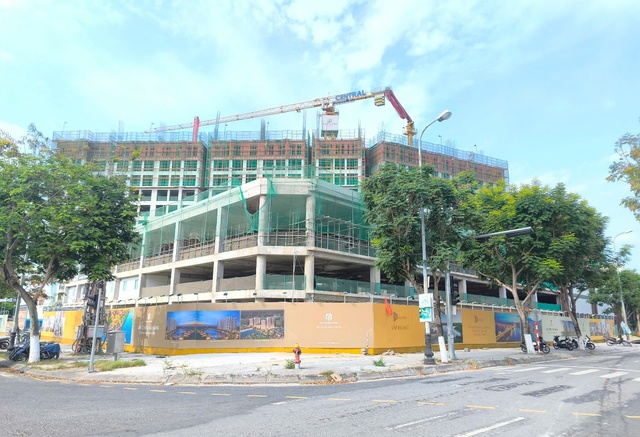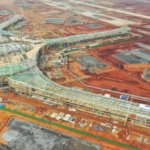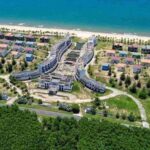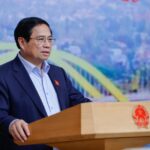Since its recognition as a centrally-governed city in 1997, Danang has undergone a remarkable transformation, evolving from a coastal tourist destination into a vibrant economic and social hub, renowned for its livability by residents, visitors, and the community alike.
From a thriving tourist destination
Strategically located between the North and South of Vietnam, and serving as the gateway to the sea for the Central Highlands and Lower Laos, Danang has long been a popular tourist destination. With almost 60 kilometers of coastline, diverse natural landscapes, and a focus on sustainable development, the city has maintained its appeal to travelers.
According to Danang’s Tourism Department, in 2019, prior to the pandemic, the city welcomed nearly 8.7 million visitors, including approximately 3.5 million international arrivals. In 2024, tourist arrivals reached 10.9 million, a 32.4% increase from 2023. International visitors surpassed 4.1 million, a 35.3% rise, while domestic tourists reached 6.7 million, up by 30.7%. Tourism revenue exceeded VND 30 trillion.
Alongside the growth in tourism, there has been a significant wave of investments in condotels, hotels, and resorts since 2015. These properties are the dominant product in the market, with numerous large-scale projects along the coastline, such as InterContinental Danang Sun Peninsula Resort, Furama, Mercure Danang, and Hyatt Regency, to name a few.
Transitioning into a multi-functional metropolis
Following the strong focus on tourism development, particularly after the Covid-19 pandemic, Danang adjusted its strategy to foster economic growth in multiple sectors, emphasizing industries such as high-tech, logistics, education, healthcare, and financial services. While tourism remains a key pillar, the city’s economy has become more diverse and vibrant.
This diversification is evident in the numbers. Danang’s GRDP in 2024 increased by 7.51%. The city’s economic scale surpassed VND 150 trillion, a rise of over VND 17 trillion compared to 2023. Labor productivity, in terms of current prices, is estimated at VND 233.2 million per person, a 10% increase from the previous year. During the 2021-2024 period, labor productivity in Danang grew by an average of 4.65% annually. Notably, in 2024 alone, the city attracted more than 19 domestic investment projects worth VND 73 trillion and granted licenses to 71 new FDI projects with a total investment of nearly USD 250 million.
With a vision to become a major economic and social hub in Vietnam and Southeast Asia by 2030, and a long-term goal of being an eco-city, a smart city, and a livable city by 2045, Danang is actively implementing policies to attract investments, upgrade infrastructure, develop smart city initiatives, and enhance administrative reforms.
The city is also transforming and establishing high-tech parks and financial and commercial districts, complemented by air, sea, road, and rail infrastructure, creating hundreds of thousands of job opportunities.
The future demands a multi-industry workforce, especially in fields like AI, chip technology, and semiconductors. According to Duy Tan University, Danang currently requires 77,000 IT personnel, but the current number stands at 44,000, indicating a need for an additional 33,000 programmers, especially in positions requiring high expertise and experience.
Becoming a “promised land” for settlement
The demand for a highly skilled workforce has spurred the development of mid-to-high-end residential projects, along with enhanced educational, healthcare, cultural, and entertainment amenities. The city is working to expand its urban space with numerous new residential areas, transportation routes, and service centers in the pipeline.
Real estate investors have quickly recognized the market’s potential. Over the past five years, Danang has witnessed a surge in real estate investments, particularly in apartments, a favored and easily accessible property type in large cities. The year 2024 stood out with a boom in both supply and liquidity.
As per DKRA Group’s market report, the central region’s capital saw over 4,300 primary apartments in 2024, a significant increase compared to 2021-2023. Nearly 70% of these were in the luxury segment, with a positive absorption rate of 76%, almost 4.6 times higher than in 2023, reflecting strong demand and buyer confidence. DKRA also forecasts a positive outlook for this segment in the coming years, supported by economic prospects and infrastructure developments.
In parallel, buyers and investors prioritize the reputation of developers, solid legal frameworks, and product quality when choosing projects for actual residence or investment purposes. This encourages established developers to continuously enhance their product offerings, diversifying supply and meeting the evolving demands of the market.
Danang’s real estate market, particularly the residential segment, is poised for further growth, with an influx of new developments, especially high-quality apartment projects, from both established and new developers. Most recently, Masterise Homes, a renowned real estate developer, shared its plans for the city: “With our international execution capability and local expertise demonstrated through our landmark projects in Hanoi and Ho Chi Minh City over the past decade, Masterise Homes is expanding its presence in Danang. Our upcoming project, part of the Masteri collection, embodies our commitment to international living standards and our dedication to elevating the quality of life for the community. We strive to create exceptional and livable developments, contributing to the city’s strategic goals and embracing new opportunities.”

An upcoming project by Masterise Homes in the heart of Hai Chau District, Danang
In mid-April, the Danang Party Committee established a steering committee for the merger of administrative units between Quang Nam and Danang. With this merger, the new Danang-Quang Nam entity is envisioned not only as the economic and social hub of Central Vietnam but also as a pioneer, leading the development of other regions. The new city aims to restructure its economy by enhancing labor productivity and leveraging its potential and strengths. It will also focus on establishing an international financial center, a free trade area, a modern coastal city, and a high-quality tourism and heritage destination…
With this strategic direction, the expanded Quang Da region will truly flourish along the vast coastline, attaining a worthy status and becoming the “promised land” for settlement among experts, highly skilled professionals, and the elite.
What’s New at Long Thanh Airport?
The Ministry of Construction has made a local adjustment to the planning of the Long Thanh International Airport in Dong Nai. This includes reducing the width of the second runway from 60m to 45m. The planning of parallel taxiways, rapid exit taxiways, connecting taxiways, and common technical infrastructure has been adjusted to ensure synchronized operation with the first runway.
Unleashing Huế’s Potential: Revitalizing Stalled Projects and Reclaiming the Billion-Dollar Golf Course Land
The city of Hue is taking a stand against the wasteful practice of stalled projects that have been left idle for years, squandering land and resources. In a decisive move, the city has initiated a comprehensive review and is taking action to address delayed constructions, with the first step being the reclamation of land earmarked for a golf course project in Thuy Duong.
“Vietnam’s High-Speed Revolution: 2,268 km of Expressways and Counting”
“On the morning of May 10, Prime Minister Pham Minh Chinh, head of the National Steering Committee for important projects and key national transport infrastructure projects, chaired the committee’s 17th meeting. As per the meeting’s updates, Vietnam now boasts an impressive 2,268 kilometers of expressway network.”
The Long Thanh Airport: Awakened from its Slumber
As of now, the country has successfully constructed 2,268 kilometers of expressways, and an additional 800 kilometers are expected to be completed by the end of the year. Notably, the Long Thanh International Airport project has come to life after years of dormancy, and the road connecting it is being actively developed.





















